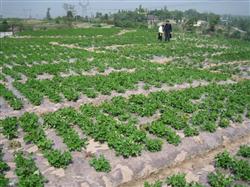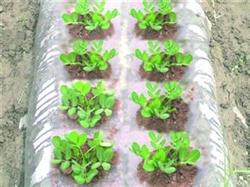Cultivation techniques of Spring Peanut covered with plastic Film

The plastic film mulching cultivation technology of spring peanut was popularized in Anxi county, the general yield was 15% higher than that of open field cultivation under similar conditions, the aspergillus flavus was reduced, the quality of peanut was improved, and good benefits were obtained. The cultivation techniques are as follows: first, the variety "Shanyou 71" with strong disease resistance, good waterlogging tolerance and suitable for planting in paddy field with good fertilizer and water conditions is selected. Second, the suitable sowing date is mainly determined by air temperature and soil moisture. When the temperature in the film is more than 15 ℃ and the soil field capacity is about 50%, the seeds can be sown. According to the production experience in recent years, the sowing date can be advanced from the middle and late March of the original open field to late February to early March. Third, seed treatment before sowing, drying seeds with shell for 2 days before sowing, promoting seed germination and emergence, and reducing the occurrence of diseases. In order to prevent rotten seeds caused by low temperature, overcast and rain in early spring, pre-sowing and infiltration treatment of seeds can also be adopted: first, spread the dry soil with 10cm thickness, put the seeds in the net bag on the soil layer (the seed thickness is about 5cm), and then cover the dry soil with 10cm for 3 days before sowing. 4. Fertilization of plastic film mulched peanut during the whole growth period, only one-time full-layer base fertilizer was used before plastic film mulching. Therefore, the base fertilizer must be fully applied. Generally, 25kg compound fertilizer is applied per 667m2 before the whole plot, or urea 10-15kg, potassium chloride 10kg and calcium superphosphate 50kg are used as base fertilizer. The fields with many underground pests should also be combined with fertilization and Milol should be used for soil treatment. After the base fertilizer is applied, one plough and more harrows should be carried out to mix the fertilizer evenly into the soil so as not to burn the seeds. After the base fertilizer is mixed, the soil is prepared and formed into a trapezoidal border, and the border surface should be flat and fine. According to the width of degradable plastic film at present, the width of furrow is 85-90cm, the width of border is 45-50cm and the height of border is 30-40cm. Fifth, sowing density and mode sowing density should be determined according to variety type, climate, soil condition, cultivation level and other factors. Generally, two rows of small beds are used, 2 seeds are sown in each hole, and the distance between the points is 17-18cm, about every 667m210000 point. The sowing depth is generally about 5cm. 6. After sowing with herbicides, each 667m2 was sprayed with 45ml (90% Acetochlor) and water 60kg. Among them, 2/3 was evenly sprayed on the border surface, and then covered with film; 1/3 after the film was covered, it was evenly sprayed around the border ditch. 7. Cover the film first with a hoe to pull the soil on both sides of the border 1/3 away from the border surface to the bottom of the ditch, and then cover the film artificially in groups of two. After the film is covered, the soil in the ditch is pressed on both sides of the film, compacted and compacted, and a small pile of soil is pressed on the border surface every 2m to protect the film. Field management 1. When the top film is unearthed from peanut cotyledons, the plastic film should be punctured with bamboo or other small hard objects in time to prevent the seedlings from burning at high temperature in the film and make the peanut seedlings grow normally. 2. water management: less water at seedling stage, proper drying of soil can promote deep root system and short and strong seedlings, moist soil at flowering stage, promote flowering and needling, and moist soil at podding stage, which can not only meet the needs of pod development, but also prevent excessive water from causing excessive growth of stems and leaves and rotten fruit. When there is insufficient water, ditch irrigation can be used to string ditch water, but the water depth does not exceed 1/3. After the border absorbs enough water, it should be drained in time; if there is too much water in rainy days, ditch drainage should be cleared in time to prevent waterlogging. 3. Pest control such as bacterial wilt and root rot should be controlled with agricultural streptomycin in time. If leaf spot occurs in the later stage of peanut growth, carbendazim and topiramine can be used to control it. 4. Harvest in time when the upper part of the peanut plant stops growing, the lower leaves fall off, the top leaves turn yellow, most of the pods in the underground are clear, full, the shell is hard and thin, and the seed coat shows the inherent color of the variety. When harvesting, you should choose sunny harvest to avoid rainy harvest.
- Prev

The main points of cotton topdressing
The main points of cotton topdressing
- Next

Eight points for attention in plastic Film mulching cultivation of Spring Peanut
The application of plastic film mulching cultivation technology in peanut production can play the role of increasing temperature, preserving whole seedlings, preserving water and fertilizer, so as to achieve the purpose of increasing yield, increasing income and striving for seasonal initiative. In 2002, our institute conducted a comparative experiment on spring peanut cultivation with plastic film mulching, and achieved a yield of 402.75 kg per mu and 367 in the field.
Related
- The first cup of black tea in spring, the flavor and history of tea gardens in Kenya, Africa
- The computer can not only choose potatoes, but also grow tea rice. AI will grow winter oolong tea champion.
- It is not only the inflated tea bitten by insects, but also engraved with the four seasons tea in Beipu.
- The Oriental Beauty Tea Festival in Zhuxian County takes the stage at the weekend to experience the plus-size feast of oil tea.
- & quot; Oriental Beauty Tea & Exploration of Emei in Hsinchu, the hometown of quot;
- The new variety of strawberry "Tainong 1" dessert is the first choice with mellow aroma. Crimson gorgeous
- History of Tea in Taiwan: from Wild Inner Mountain to Export Tea Garden
- Two types of Taiwan Oriental Beauty Black Tea won the British three-Star Award for Childhood Tea Xiang Zhang Jiaqi changed from pilot to champion tea maker.
- Banana species and varieties: the planting history of Taiwan Xianren banana and dwarf banana is long, is banana disease resistant?
- Coffee planting Technology: Qianjie Coffee from Seedling to harvesting

